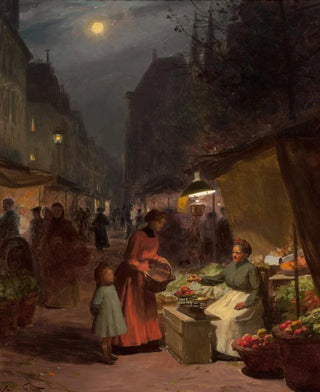Art print | The fruit seller - Victor Gabriel Gilbert


View from behind

Frame (optional)
In the vast panorama of 19th-century French art, "The Fruit Seller" by Victor Gabriel Gilbert stands out for its ability to capture everyday life with poignant sensitivity. This artwork, imbued with realism, immerses us in a fleeting moment of urban life, where the vibrant colors of the fruits seem almost tangible. Gilbert, a master of the genre, manages to evoke not only the subject but also the atmosphere of a lively market, where scents and sounds intertwine to create an immersive sensory experience. Through this art print, the viewer is invited to rediscover the beauty of simple moments, elevated by the talent of an artist who knows how to seize the essence of his era.
Style and uniqueness of the work
Gilbert's style is characterized by meticulous realism, where every detail is carefully crafted to pay homage to the beauty of everyday life. In "The Fruit Seller," the fruits are painted with such precision that they seem to almost emerge from the canvas. The play of light and shadow, skillfully orchestrated, adds depth to the scene, while the faces of the characters, though simple, express a range of emotions that enrich the visual storytelling. This painting does not merely depict a simple commercial transaction; it tells a story, that of a man, his labor, his hopes, and his dreams. The composition, balanced and harmonious, guides the viewer's gaze through the different layers of the scene, thus revealing the richness of urban life of the time.
The artist and his influence
Victor Gabriel Gilbert, born in 1847, is a painter whose work is rooted in the realism movement but does not limit itself to a mere reproduction of reality. Influenced by the great masters of his time, he develops a style that is uniquely his own, combining impeccable technique with human sensitivity. Gilbert has managed to establish himself on the artistic scene thanks to his ability to depict scenes of everyday life with such authenticity that they still resonate today. His works, often centered on themes of popular life, testify to a deep empathy for his subjects. As an artist, he contributed

Matte finish

View from behind

Frame (optional)
In the vast panorama of 19th-century French art, "The Fruit Seller" by Victor Gabriel Gilbert stands out for its ability to capture everyday life with poignant sensitivity. This artwork, imbued with realism, immerses us in a fleeting moment of urban life, where the vibrant colors of the fruits seem almost tangible. Gilbert, a master of the genre, manages to evoke not only the subject but also the atmosphere of a lively market, where scents and sounds intertwine to create an immersive sensory experience. Through this art print, the viewer is invited to rediscover the beauty of simple moments, elevated by the talent of an artist who knows how to seize the essence of his era.
Style and uniqueness of the work
Gilbert's style is characterized by meticulous realism, where every detail is carefully crafted to pay homage to the beauty of everyday life. In "The Fruit Seller," the fruits are painted with such precision that they seem to almost emerge from the canvas. The play of light and shadow, skillfully orchestrated, adds depth to the scene, while the faces of the characters, though simple, express a range of emotions that enrich the visual storytelling. This painting does not merely depict a simple commercial transaction; it tells a story, that of a man, his labor, his hopes, and his dreams. The composition, balanced and harmonious, guides the viewer's gaze through the different layers of the scene, thus revealing the richness of urban life of the time.
The artist and his influence
Victor Gabriel Gilbert, born in 1847, is a painter whose work is rooted in the realism movement but does not limit itself to a mere reproduction of reality. Influenced by the great masters of his time, he develops a style that is uniquely his own, combining impeccable technique with human sensitivity. Gilbert has managed to establish himself on the artistic scene thanks to his ability to depict scenes of everyday life with such authenticity that they still resonate today. His works, often centered on themes of popular life, testify to a deep empathy for his subjects. As an artist, he contributed






